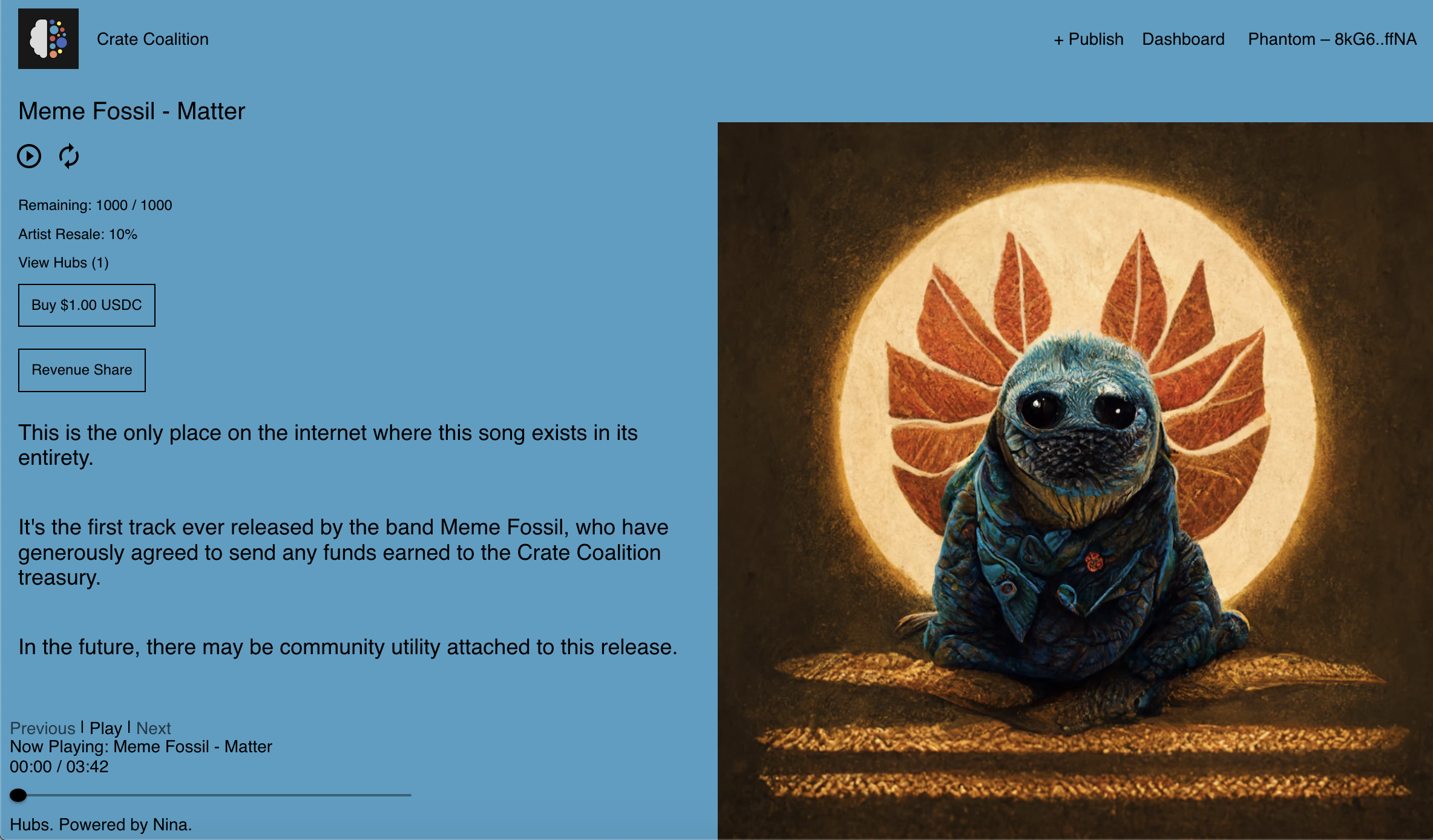Taking the Nina Protocol’s Music Publishing Service The Hub for a Spin
A walk through on how to publish music and essays on the Solana blockchain using the Nina Protocol.

A web3 music platform powered by Solana offers “a new way to publish, share, and discuss music.”
As we increasingly move to digital spaces and transact in online economies, it’s essential that we don’t fall into habits of isolated consumption – lest we forget there are human beings on both ends of every song.
Web3 music is abundant with variations on this theme – at least in its rhetoric – but many organizations in the space are over-indexing on music as a financial instrument, in some cases explicitly labeling it an asset.
It’s hard to fault those who are looking through a financialized lens. The freemium model for streaming, which places an infinity of music at our fingertips for less than the price of a CD a month, has normalized the devaluation of music: 98.6 percent of Spotify artists are earning $36 per quarter. So revaluation should be a priority, but overemphasis on the financial aspects puts the essence of music at risk.
One project that’s keeping music central is Nina, a new web3 protocol for buying, selling and streaming music. Yes music is also an asset on Nina, but that’s not the reason it stands out. It stands out because it’s built around the humans on both sides of every song – money is just a byproduct, the vehicle for transacting.
The team explicitly elides web3 buzzwords like ‘NFTs’ while prioritizing connective features like the Hub, a mechanism at the protocol level that tracks relationships built around music. They describe the Hub conceptually as part of their “context as curation” approach. Intrigued, I recently tested the feature to better understand how people on both sides can derive value from the project.
Last October, I interviewed Nina’s co-founders: Mike Pollard, Jack Callahan and Eric Farber. When I shared the published piece, I quoted Pollard, who during our interview had suggested that Nina could become the "infrastructure for the next 50 years of music.” In my tweet I explained why: it’s simple, connective, contextual, made by musicians, and written in the "languages of the counterculture."
The Hub is the underlying network that weaves together the pieces. There are various use cases for a Hub, and in their FAQ the team expounds upon how artists, fans, labels, music bloggers and venues are just some of the entities that can glean value from the feature.
Read more: The Nina Protocol Formed More Like a Band Than a Startup and Wants to Leave More Cash and Control With Artists
It felt natural to use the space for Grey Matter, an aligned music project I’ve been captaining for the past couple years. Grey Matter is a community layer on top of existing streaming platforms, and parallel to the platform is the Crate Coalition, a fledgling community rooted in cratedigging lore that’s committed to a more interdependent music ecosystem.
Cratedigging, like Nina, is not simply an act of seeking and buying. It’s a hunt for DNA. It’s a belief that curation is care. It's an adventure outside the closed walls of our streaming platforms and into the hearts and minds of other human beings. Cratedigging is a lens into – and a metaphor for – our collective love and appreciation for music.
To begin the process, Nina’s Jack Callahan sent a publishing token to my Phantom wallet, which is a digital wallet built around the Solana blockchain (you can also connect the Solflare, Glow and Backpack wallets). On Nina, I created a permanent handle and committed a very small amount of $SOL – the currency that powers Solana – to cover gas costs. In the process, there were three signature requests: two to confirm storage on Arweave and one to finalize the Hub.
Once confirmed, I created the Hub, which felt reminiscent of building a Bandcamp page, as it includes some basic aesthetic customization (background and text colors) but kept the focus on the content and its context.
To test the protocol, I minted the song we used as the intro and outro for the Grey Matter podcast, Community Matters – a series where artists shared their stories on how other people impact their music. The song is called “Matter” and was written and produced by the band, Meme Fossil, who generously gave us permission to use the song in this experiment. It doesn’t exist on web2 streaming platforms or anywhere else in its entirety, but it will now be forever stored on Arweave.
Check out MacEagon’s Hub
$SOL is used to pay for storage on Arweave, so the bigger the file, the more costly the transaction. The costs, though, are minimal – I paid a whopping $0.02 to store 8.6 megabytes of data. I uploaded the mp3 alongside the band’s album art and filled out some standard metadata like title, description and catalog number, as well as release parameters like number of releases to make available, retail price, and resale percentage – the percentage earned if and when the release is sold on secondary markets (I chose the standard 10 percent). Hub owners can also add collaborators and other wallets that will automatically receive splits from the revenue of each sale.
In the future, we may attach community utility to this token, so it felt important to opt for high volume (1,000 releases) and low price (they’re a buck a piece). Once ready, I moved through an “are you sure you’re ready” modal – this is permanent and unalterable, after all – and then used my wallet to sign four more signature requests: one each to upload the artwork, song, and metadata to Arweave and one to send the $SOL.
The sheer number of signatures required to create a profile, post music and even follow and unfollow people is a point of friction for which many will have to practice patience. We’re accustomed to hyper-optimized consumer apps, where even one extra click can deter would-be customers. The trade-off, of course, is enduring, verifiable and sovereign data, and it’s one that I think is worth making. Time will tell if other visitors are willing to make that deal.
Once the minting process was complete (coincidentally “Matter” was Nina’s thousandth release), I created a post to contextualize the track and shared it to the Hub – a social feature painfully absent from the current streaming environs, where music is abstracted from social context, and community building is outsourced to noisy social networks like Instagram.
Nina co-founder Mike Pollard
A nice addition to Nina would be a more robust discovery element, where posts are included in an easily accessible feed from the main site – Pollard assured me this is on the way, alongside other improvements to the post feature.
In that vein it will take time for the full benefit of Nina’s infrastructure to take shape – and that will require work both inside and outside of its own ecosystem. “Matter” and other Nina releases, for instance, will also exist on integrated web3 players/aggregators like Future Tape and Spinamp. “We like the idea of aggregators and think they'll be an important surface for discovery and context,” Pollard told me. “They are the application layer of web3 music protocols.”
The Nina devs helped both organizations through their scripts to facilitate integration, a testament to the collaborative non-zero-sum-game Nina and many web3 music organizations are out to play. “I don't think [aggregators have] shown what they're fully capable of yet,” Pollard said.
And neither has Nina. It will take more music, engagement and building for the Nina network to truly flourish, but the infrastructure is there, and the values are well-placed. The Crate Coalition will continue to build our collection on our Hub, using it to share live sets from events and to repost other songs and content from across the Nina landscape. Hopefully, over the coming years, we normalize its “context as curation” approach and are well on our way toward a more reciprocal and less extractive music industry.


